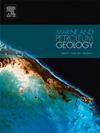Tide to river-dominated changes in the early Miocene mixed-energy paralic western shelf of the Pearl River Mouth Basin, northern South China Sea
IF 3.7
2区 地球科学
Q1 GEOSCIENCES, MULTIDISCIPLINARY
引用次数: 0
Abstract
Many modern paralic depositional systems are characterized by complicated morphologies mixed with the river, tide, and wave processes. However, the prediction of hydrodynamic processes within their ancient counterparts is challenging from the subsurface data due to the limitation of resolution and coverage. This study illustrates an integrated work on the mixed-energy paralic deposits of the lower Miocene Zhujiang Formation in the western shelf of the Pearl River Mouth Basin, northern South China Sea. Through a synthesis of grain size and heavy mineral analysis, well-based facies interpretation, and seismic stratigraphic study, it generally shows a vertical change from the dominance of tidal strait deltas and tide-influenced deltas to a river-dominated delta with the wave-dominated shelf throughout three members, in response to the evolution from semi-closed to open marine settings. Tidal, river, and wave signals were recognized from the mixed-energy paralic deposits, albeit with alternative interpretations and non-negligible limitations. Tidal processes, which were interpreted from grain size distribution unmixing and statistical heavy mineral comparison, intensified towards the distal reach in the Member 2, and they generally declined after the drowning of paleo-Highs in the Member 1–2. Fluvial processes, which were reflected by heavy mineral evidence and sedimentary response, significantly enhanced from Member 2 to Member 1-1 with more extensive drainages and increased sediment supply, despite the long-term transgression. The presence of large-scale shoreline-parallel shelf sand ridges in the Member 1-1 was mostly controlled by the wind-driven Guangdong Coast Currents and intrusion of the South China Sea Branch of Kuroshio Current, which were coupled with the maximum East Asian Monson intensity and the Indonesian Seaway shoaling before the final closure. We demonstrated that a multidisciplinary approach presented can be effectively used to assess the changes in hydrodynamic processes of mixed-energy depositional systems, which unravel more paleogeographic, paleoclimatic, and paleoceanographic information from depositional records.
求助全文
约1分钟内获得全文
求助全文
来源期刊

Marine and Petroleum Geology
地学-地球科学综合
CiteScore
8.80
自引率
14.30%
发文量
475
审稿时长
63 days
期刊介绍:
Marine and Petroleum Geology is the pre-eminent international forum for the exchange of multidisciplinary concepts, interpretations and techniques for all concerned with marine and petroleum geology in industry, government and academia. Rapid bimonthly publication allows early communications of papers or short communications to the geoscience community.
Marine and Petroleum Geology is essential reading for geologists, geophysicists and explorationists in industry, government and academia working in the following areas: marine geology; basin analysis and evaluation; organic geochemistry; reserve/resource estimation; seismic stratigraphy; thermal models of basic evolution; sedimentary geology; continental margins; geophysical interpretation; structural geology/tectonics; formation evaluation techniques; well logging.
 求助内容:
求助内容: 应助结果提醒方式:
应助结果提醒方式:


